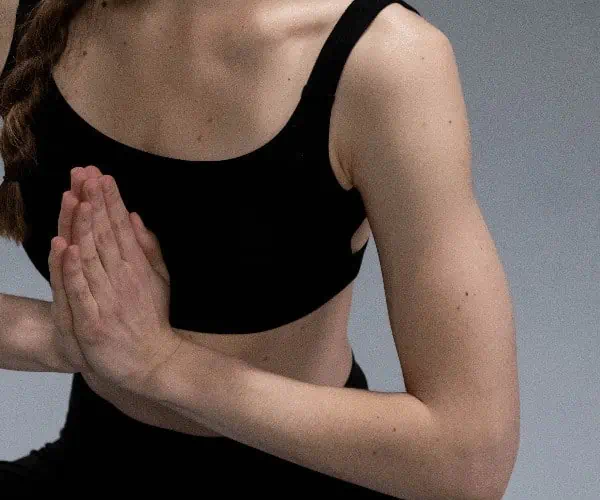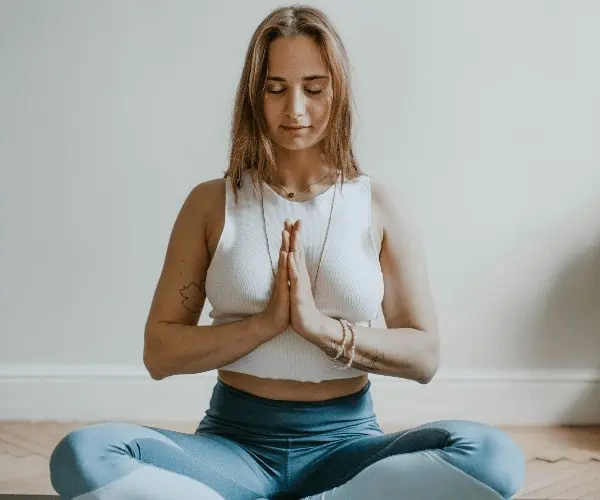The Niyamas are integral to yoga philosophy and meditation and guide personal growth, mental hygiene, and mindfulness through observances and habits. Incorporating meditation and yogic philosophy into your weekly yoga practice can enhance your overall well-being and aid in cultivating bodily health.
The transformative impact of practicing the Niyamas, the second limb of yoga philosophy, is profound and enduring. These enriching aspects of yoga extend beyond physical postures or asanas.
Once you begin adopting principles of Niyamas yoga philosophy into your daily life, you’re likely to find yourself making healthy choices in other areas of life beyond your yoga mat. This includes mental hygiene and cultivating positive habits.
Contents
- 1 Defining the Five Pillars of Niyamas
- 2 Unveiling Saucha: Embracing Cleanliness
- 3 Santosha: Path to Contentment Explored
- 4 Tapas: Self-Discipline in Niyamas Yoga
- 5 Svādhyāya: A Closer Look at Self-Study in Niyama Practice
- 6 Ishvara Pranidhana: The State of Surrender
- 7 Concluding Thoughts on Niyama Yoga
- 7.1 What are the benefits of practicing Niyamas in Yoga?
- 7.2 How can I incorporate the Niyamas into my daily routine?
- 7.3 Can beginners practice the Niyamas?
- 7.4 Do I need any special equipment to practice the Niyamas?
- 7.5 How long does it take to see the benefits of practicing Niyamas?
- 7.6 Can I practice Niyamas without doing physical yoga postures?
- 7.7 Was this helpful?
Defining the Five Pillars of Niyamas
The Niyamas are the second of eight limbs of yoga as defined by Sage Patanjali in the Yoga Sutras. They are personal ethical guidelines used initially by sages and yogis to cleanse the body and mind of impurities. These habits can shape the mind and bring one closer to god and spiritual enlightenment.
A Quick Look at Each Pillar
Niyama yoga includes five core pillars:
- Saucha: physical cleanliness, health, and purity
- Santosha: contentment and acceptance
- Tapas: discipline, motivation, and perseverance
- Svādhyāya: self-study and introspection
- Ishvara Pranidhana: surrender to a higher power
The Interconnectedness Among the Pillars
These pillars are not standalone; they’re interconnected. Take these examples:
- Maintaining Saucha (mental and physical cleanliness) requires Tapas (discipline), but with effort, it can lead to Santosha (contentment).
- Tapas (discipline) could help one commit to Svādhyāya (self–study).
- Practicing Santosha (acceptance) can encourage Ishvara Pranidhana (surrender).
This practice tip can help form good habits, deepen your yoga practice, and bring you closer to god.
Foster Self-Awareness Through the Pillars
Each pillar, forming our habits, plays a vital role in fostering self-awareness. Observing these ethical guidelines and habits regularly makes you more aware of your thoughts and actions, no matter your situation.
Shaping Your Yoga Practice with Niyamas
The Niyamas shape one’s yoga practice significantly. These habits act as a moral code that guides your behavior on and off the mat.
Incorporating these habits into your life and routine can enhance your physical performance and mental well-being.
Unveiling Saucha: Embracing Cleanliness

What is Saucha?
Saucha, a habit in the limb of niyama yoga, stands for cleanliness. This refers to not just physical but also mental hygiene.
The sages of yore recognized its importance. They saw it as a way to cultivate bodily health and mental clarity. Removing impurities from the mind and body was crucial to spiritual enlightenment.
Saucha and Healthy Living
Healthy living isn’t just about diet and exercise. It’s also about being clean – inside and out, including mental hygiene.
Saucha encourages us to get rid of impurities. These could be toxins in our bodies or negative thought patterns in our minds.
Impact on Yoga Practice
When we commit to Saucha, we can see a change in our yoga practice. Our focus sharpens; we become more present in the moment.
This clarity allows us to connect with the divine purpose of yoga. Our practice becomes an exercise routine and a path toward truth and enlightenment.
Bringing Saucha into Daily Life
So, how do you incorporate Saucha into your day-to-day life? Here is a list with some practical ways to make it:
- Keep your environment clean. Organize your place to cut down on clutter.
- Eat healthy, nourishing food during the week.
- Take time each day for self-care.
- Practice mindfulness and positive thinking.
Remember that every small step counts! Even if you start with just one thing – like keeping your home tidy (a nice idea) – you’ll soon see the benefits spilling over into other areas of your life.
Saucha is not just about simply cleanliness for cleanliness’ sake; it’s about creating a healthy lifestyle that helps us live with confidence and purpose every day.
Santosha: Path to Contentment Explored
Santosha is all about finding inner peace and satisfaction with the present. It’s a tranquil path to ease stress and foster a positive mindset.
Grasping Santosha: Inner Peace
Santosha isn’t just about being happy when things are good. It’s about finding peace no matter what life throws at you. This state of divine contentment comes from within, not from external sources.
- Example: Even if you lose your job or fail at something, Santosha encourages you to find inner peace amidst these challenges. It helps you accept things as they are rather than becoming stuck in negative thought patterns about what might have been.
Santosha Reduces Stress
Studies show that practicing Santosha can significantly reduce stress levels. When we learn to be content with our lives as they are now, we stop worrying so much about the future or dwelling on the past.
- Scientific support: A 2018 study found that experiential acceptance training combined with mindfulness practice maximized the stress-relief effects compared to mindfulness alone.
Cultivating a Positive Mindset with Santosha
Incorporating Santosha into your yoga practice can help cultivate a positive mindset. By focusing on gratitude for what we have right now, we can let go of negative thoughts and expectations and help our bodies in the process.
- Santosha practice tip: next time you’re in a yoga class, try to focus on what your body is capable of rather than comparing yourself to what someone else’s pose looks like. Be content with where you are in your yoga journey and the effort you’ve put in to get where you are!
Santosha is about letting go of expectations and being present with your experience exactly as it is. That’s why many yogis report feeling more optimistic and less anxious after incorporating Santosha into their practice.
Fostering Santosha in Everyday Life
You don’t need to be on a yoga mat to cultivate Santosha! Simple habits like expressing daily gratitude, practicing mindfulness, and letting things be as they are without trying to control every experience can foster this sense of ease and well-being in everyday situations.
- Social Proof: Celebrities like Oprah Winfrey swear by daily gratitude practices to foster happiness and success! Starting a daily gratitude practice with a journal like this is easy!
Tapas: Self-Discipline in Niyamas Yoga

The Essence of Tapas
Tapas, a critical aspect of niyama yoga, symbolizes consistent improvement efforts. It’s about embracing discipline and making positive choices in order to serve your highest good.
Building Resilience Through Tapas
Tapas and resilience go hand-in-hand in yoga practice. We build strength and resilience by sticking to our physical practice, even when it’s tough.
- Tapas practice tip: Consider holding a challenging asana (Chair Pose, for example). It’s not easy, right? Sometimes, the negative thought patterns take over, and we tell ourselves, “This is too hard, my legs are shaking, I can’t do it!”
Instead, use your Tapas to change your internal dialogue, and tell yourself you can hold the pose for one more second or one more breath (notice: this is also practicing Saucha of the mind, a.k.a. mental hygiene!), and pretty soon, you’ll be able to hold that pose without a second thought!
When you regularly bring Tapas into your activities, you build up strength, which also increases your confidence. It’s a win-win!
Impacting Long-Term Goals
The impact of tapas extends beyond the mat. It influences how we act outside our yoga sessions.
- For example, eating a balanced diet is an act of tapas. This choice supports our long-term health goals.
Integrating Tapas into Routine
Integrating tapas into your routine isn’t rocket science. Here are some practice tips:
- Start small: Don’t bite off more than you can chew.
- Stay consistent: Make your actions habitual.
- Celebrate every success: Recognizing your progress will keep you motivated!
- Be patient: Change takes time.
Incorporating these strategies will help foster self-discipline in all areas of life.
Svādhyāya: A Closer Look at Self-Study in Niyama Practice
Unveiling Svādhyāya
Svādhyāya, in definition, is a Sanskrit term that is often translated as “self–study” or “self–education.” It is a key concept in yogic philosophy and various spiritual practices.
Svādhyāya involves introspection, self-reflection, and the study of sacred texts. It is a process of self-discovery and understanding that encourages individuals to explore their inner selves and relationship with the universe.
This practice enhances self-awareness and promotes personal growth and spiritual development. Svādhyāya is often considered a life-long journey toward realization and enlightenment.
Svādhyāya in Yoga Practice
In the context of yoga, Svādhyāya is the practice of self-study and self-analysis, which involves observing one’s thoughts, emotions, and actions. It’s about cultivating self-awareness and understanding our inner selves at a deeper level.
This process helps to identify and let go of negative patterns, leading to personal growth and transformation.
Svādhyāya can be practiced in several ways in yoga. It can involve studying ancient yogic texts, chanting mantras, or observing one’s thoughts during meditation. It can also be practiced off the mat, in daily life, by watching our reactions and behaviors in different situations.
In essence, Svādhyāya is a journey towards self–understanding and self–improvement. It’s about recognizing our strengths and weaknesses, desires and fears, and becoming the best version of ourselves on and off the yoga mat.
The Importance of Svādhyāya in Daily Life
Svādhyāya can bring a multitude of benefits.
Firstly, it helps us identify our strengths and weaknesses, leading to personal development and self-improvement. By understanding ourselves better, we can work on our weaknesses and leverage our strengths more effectively.
Secondly, Svādhyāya helps us connect to our higher purpose. When we know our true selves, we can set goals and intentions to help us live meaningfully.
Thirdly, the practice of Svādhyāya encourages us to embrace life’s challenges. When we encounter a difficult situation in our yoga practice or at our job, we can use the experience as an opportunity for self-discovery and growth.
Lastly, Svādhyāya can foster a deeper connection with others. By understanding ourselves better, we can also understand others more effectively. This can lead to improved relationships and greater empathy and compassion.
Svādhyāya is a philosophical concept and a practical tool that can enhance our daily lives. Incorporating this practice promotes self-growth, mindfulness, and improved relationships, leading to a more fulfilling and balanced life.
How to start practicing Svādhyāya
- Start with introspection, reflecting on your thoughts, actions, expectations, and feelings daily.
- Be mindful, focusing on the present moment.
- Regularly read and reflect on a chosen sacred text.
- Meditate to quiet your mind and understand yourself better.
- Keep a journal to track your thoughts and progress.
- Practice non–judgment, accepting yourself as you are.
- Apply the insights from Svādhyāya for positive changes in your life.
- Share your insights for the well-being of others.
- Stay consistent, making Svādhyāya a daily habit.
- Be patient, as self-study is a lifelong journey.
Ishvara Pranidhana: The State of Surrender

Ishvara Pranidhana is a significant element in Niyama yoga, emphasizing surrender to a higher power. It teaches us to relinquish control, fostering trust and faith during challenging times.
What’s Ishvara Pranidhana Anyway
Ishvara Pranidhana is similar to Santosha as it shares the element of acceptance of what is. However, Ishvara Pranidhana takes that acceptance to the next level: it’s about offering your efforts to the universe or a higher power.
Have you ever heard the saying, “Let go, and let God?” That’s the main idea here. You release control to a higher power and allow things to be as they are.
The Link with Yoga Practice
In yoga, we often strive for perfect form. But sometimes, we need to let go and trust the process. That’s where Ishvara Pranidhana comes in – it reminds us that it’s not all about our individual effort.
A Beacon in Tough Times
Life can throw some serious curveballs at us. During these times, the practice of Ishvara Pranidhana can be a lifeline. It encourages us to have faith and trust that things will work out.
Applying it daily
Ishvara Pranidhana can bring a sense of ease to your day-to-day living. Try these practices and see for yourself:
- Begin your day with a short prayer, mantra, or expression of gratitude to the divine (God, the universe, or whatever higher power you connect with).
- When faced with challenges, remember to let go and trust the process.
- At the end of the day, reflect on how you’ve practiced acceptance.
By embracing this concept in everyday life, we can cultivate peace within ourselves and gracefully navigate life’s ups and downs.
Concluding Thoughts on Niyama Yoga

The Niyamas, the second of the Eight Limbs of Yoga, offer a structured path for self-improvement and spiritual growth.
Through Saucha, Santosha, Tapas, Svādhyāya, and Ishvara Pranidhana, practitioners can foster cleanliness, contentment, self-discipline, self-study, and self-surrender respectively. Embracing these principles enhances your yoga practice and improves your overall well–being.
Incorporating the Niyamas into your daily life may seem daunting initially. However, with consistent practice and dedication, they become second nature. Start by focusing on one aspect at a time to avoid overwhelm.
As you progress in your journey of self–discovery through Niyama’s yoga, remember that it’s about personal growth rather than perfection.
What are the benefits of practicing Niyamas in Yoga?
The Niyamas in yoga provide a pathway towards achieving inner peace and harmony.
They help individuals cultivate positive habits such as cleanliness (Saucha), contentment (Santosha), discipline (Tapas), self-study (Svādhyāya), and surrender to a higher power (Ishvara Pranidhana).
How can I incorporate the Niyamas into my daily routine?
Start by focusing on one Niyama at a time. For instance, you could begin with Saucha by maintaining physical health and gradually move on to cultivating mental purity. Over time, these practices will become part of your everyday life.
Can beginners practice the Niyamas?
Absolutely! The beauty of the Niyamas lies in their adaptability to all levels of practitioners — from beginners to advanced yogis.
Do I need any special equipment to practice the Niyamas?
No special equipment is required to practice the Niyamas. All you need is an open mind and willingness to explore yourself profoundly and have a pleasant experience.
How long does it take to see the benefits of practicing Niyamas?
The time it takes to see the benefits of practicing Niyamas varies from person to person. It largely depends on your consistency, dedication, and personal growth.
Can I practice Niyamas without doing physical yoga postures?
Yes, you can practice the Niyamas independently of physical yoga postures. However, combining both can enhance your overall yoga experience.


